![]()
![]()
![]()
Use LEFT and RIGHT arrow keys to navigate between flashcards;
Use UP and DOWN arrow keys to flip the card;
H to show hint;
A reads text to speech;
117 Cards in this Set
- Front
- Back
|
Which one of the following is an example of significant radiative heat transfer? A. Heat transfer from one fuel rod to an adjacent fuel rod during stable film boiling. B. Heat transfer from the center to the edge of a fuel pellet at end of core life. C. Heat transfer from the reactor coolant to the feedwater in a steam generator. D. Heat transfer from the fuel cladding to the reactor coolant via subcooled nucleate boiling.
|
A.
|
|
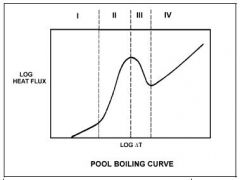
Refer to the drawing of a pool boiling curve (see figure below). Identify the region of the curve where the most efficient form of heat transfer exists. A. Region I B. Region II C. Region III D. Region IV
|
B.
|
|
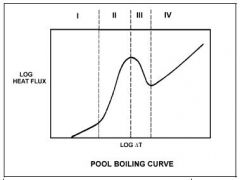
Refer to the drawing of a pool boiling curve (see figure below). Which region of the curve contains the operating point at which the hottest locations of a nuclear reactor normally operate to transfer heat from the cladding to the coolant at 100 percent power? A. Region I B. Region II C. Region III D. Region IV
|
B.
|
|
|
Why does nucleate boiling improve heat transfer in a nuclear reactor core? A. The formation of steam bubbles at nucleation sites on the fuel clad allows more heat to be transferred by conduction. B. The formation of steam bubbles at nucleation sites on the fuel clad promotes local radiative heat transfer and allows more heat to be transferred by convection. C. Heat is removed from the fuel rod as both sensible heat and latent heat of condensation, and the heat is transferred directly to the coolant by radiative heat transfer. D. Heat is removed from the fuel rod as both sensible heat and latent heat of vaporization, and the motion of the steam bubbles causes rapid mixing of the coolant.
|
D.
|
|
|
Convection heat transfer improves when nucleate boiling begins on the surface of a fuel rod because: A. steam bubble formation decreases coolant flow along the fuel rod. B. steam bubble formation increases coolant flow along the fuel rod. C. a steam blanket begins to form along the surface of the fuel rod. D. the motion of the steam bubbles causes rapid mixing of the coolant.
|
D.
|
|
|
How does the convective heat transfer coefficient vary from the bottom to the top of a fuel rod if subcooled reactor coolant enters the coolant channel and exits as superheated steam? A. Increases continuously B. Increases, then decreases C. Decreases continuously D. Decreases, then increases
|
B.
|
|
|
Nucleate boiling affects heat transfer from a fuel rod primarily by... A. increasing the conductive heat transfer from the fuel rod to the coolant. B. increasing the convective heat transfer from the fuel rod to the coolant. C. decreasing the conductive heat transfer from the fuel rod to the coolant. D. decreasing the convective heat transfer from the fuel rod to the coolant.
|
B.
|
|
|
Subcooled water enters the bottom of an operating nuclear reactor core. As the water flows upward past the fuel assemblies, boiling begins at the surface of a few fuel rods. If the coolant at the surface of those fuel rods had remained subcooled, average fuel temperature in the affected fuel rods would have been ________ because single-phase convection is a ________ efficient method of heat transfer than boiling at the surface of the fuel rods. A. higher; more B. higher; less C. lower; more D. lower; less
|
B.
|
|
|
Case 1: Pure subcooled reactor coolant is flowing through a fuel assembly in a reactor core operating at steady-state full power. As the coolant flows upward through the fuel assembly, the water heats up and exits the fuel assembly still subcooled. Case 2: Same as above except that reactor coolant system pressure is decreased such that the coolant begins to boil halfway up the fuel assembly, which results in a saturated steam-water mixture exiting the fuel assembly. Assume departure from nucleate boiling is avoided in both cases and that both cores continue to operate at full power. As compared to Case 1, the average fuel temperature for Case 2 will be ________ because boiling is a ________ efficient method of heat transfer. A. higher; more B. higher; less C. lower; more D. lower; less
|
C.
|
|
|
Subcooled reactor coolant flows into the bottom of a fuel assembly coolant channel and exits the top of the channel as a saturated steam-water mixture with a 98 percent moisture content. How does the overall heat transfer coefficient in the coolant channel change as the coolant travels upward along the channel? A. Increases only. B. Increases, then decreases. C. Decreases only. D. Decreases, then increases.
|
A.
|
|
|
Subcooled water is flowing into a fuel assembly in an operating nuclear reactor core. As the water flows upward through the fuel assembly, some of the water in contact with the fuel rods begins to boil. If fuel assembly power is unchanged and system pressure is increased such that all of the water remains subcooled, the average fuel temperature in the fuel assembly would be ________ because boiling is a ________ efficient method of heat transfer. A. higher; more B. higher; less C. lower; more D. lower; less
|
A.
|
|
|
Initially, subcooled water is flowing into a fuel assembly, with subcooled water exiting the fuel assembly several degrees hotter than when it entered, and no boiling is occurring in the fuel assembly. Assume that fuel assembly thermal power and water flow rate remain the same. System pressure is decreased, causing some of the water in contact with the fuel rods to boil during transit through the fuel assembly. If the water exiting the fuel assembly remains subcooled, the average fuel temperature in the fuel assembly will be ________, and the temperature of the water exiting the fuel assembly will be ________. A. higher; the same B. higher; higher C. lower; the same D. lower; higher
|
D.
|
|
|
Subcooled nucleate boiling is occurring along a heated surface. If the heat flux is increased slightly, what will be the effect on the ¥T between the surface and the fluid? (Assume subcooled nucleate boiling is still occurring.) A. Small increase in ¥T because of steam blanketing. B. Large increase in ¥T because of steam blanketing. C. Small increase in ¥T as vapor bubbles form and collapse. D. Large increase in ¥T causing radiative heat transfer to become significant.
|
C.
|
|
|
As heat is transferred to water adjacent to a heating surface, many factors influence steam bubble formation. Which one of the following characteristics will enhance steam bubble formation? A. Chemicals dissolved in the water B. The absence of ionizing radiation exposure to the water C. A highly polished heat transfer surface with minimal scratches or cavities D. The presence of gases dissolved in the water
|
D.
|
|
|
What type of boiling is described as follows: The bulk temperature of the liquid is below saturation, but the temperature of the heat transfer surface is above saturation. Vapor bubbles form at the heat transfer surface, but condense in the cold liquid so that no net generation of vapor is obtained. A. Bulk boiling B. Subcooled nucleate boiling C. Total film boiling D. Partial film boiling
|
B.
|
|
|
Which one of the following is a characteristic of subcooled nucleate boiling but not saturated nucleate boiling? A. TClad equals TSat B. TClad is greater than TSat C. TBulk Coolant equals TSat D. TBulk Coolant is less than TSat
|
D.
|
|
|
Which one of the following is a characteristic of saturated nucleate boiling but not subcooled nucleate boiling? A. TBulk Coolant equals TSat B. TBulk Coolant is less than TSat C. TClad equals TSat D. TClad is greater than TSat
|
A.
|
|
|
Which one of the following describes why the core heat transfer rate increases when nucleate boiling begins on the surface of a fuel rod? A. Steam has a greater thermal conductivity than water. B. The formation of steam bubbles increases coolant flow rate along the fuel rod. C. Radiative heat transfer begins to supplement convective heat transfer. D. Heat transfer by steam bubble formation is more effective than through a liquid film.
|
D.
|
|
|
Which one of the following modes of heat transfer is characterized by steam bubbles moving away from a heated surface and collapsing in the bulk fluid? A. Bulk boiling B. Subcooled nucleate boiling C. Saturated nucleate boiling D. Saturated natural convection
|
B.
|
|
|
A nuclear reactor is operating at 100 percent power. Which one of the following will increase the likelihood of vapor bubble formation in the reactor coolant? A. Surface scratches or cavities in the fuel clad B. Subsurface void defect in the fuel clad C. Increased coolant velocity past the fuel rods D. Chemically inert material dissolved in the coolant
|
A.
|
|
|
A nuclear power plant is currently shut down after several months of operation at full power. The shutdown cooling system is in operation, maintaining an average reactor coolant temperature of 280EF. A pressure control malfunction causes RCS pressure to slowly and continuously decrease from 100 psia while reactor coolant temperature remains constant. (Assume an upward reactor coolant flow direction through the core.) Which one of the following describes where nucleate boiling will first occur? A. At a scratch on the surface of a fuel rod near the top of a fuel assembly. B. At a scratch on the surface of a fuel rod near the bottom of a fuel assembly. C. In the bulk fluid of a coolant channel near the top of a fuel assembly. D. In the bulk fluid of a coolant channel near the bottom of a fuel assembly.
|
A.
|
|
|
If departure from nucleate boiling is reached in the core, the surface temperature of the fuel clad will... A. increase rapidly. B. decrease rapidly. C. increase gradually. D. decrease gradually.
|
A.
|
|
|
If ¥T is the temperature difference between the fuel rod clad surface and the bulk coolant, which one of the following describes the heat transfer from a fuel rod experiencing departure from nucleate boiling? A. Steam bubbles begin to blanket the fuel rod clad, causing a rapid increase in the ¥T for a given heat flux. B. Steam bubbles completely blanket the fuel rod clad, causing a rapid decrease in the ¥T for a given heat flux. C. Steam bubbles begin to form on the fuel rod clad, causing a rapid decrease in the heat flux from the fuel rod for a given ¥T. D. Steam bubbles completely blanket the fuel rod clad, causing a rapid increase in the heat flux from the fuel rod for a given ¥T.
|
A.
|
|
|
Departure from nucleate boiling should not be allowed to occur in the core because the... A. steam bubbles begin to blanket the clad and decrease radiative heat transfer. B. steam bubbles in the coolant may cause flow oscillations. C. rapid increase in ¥T between the clad and the coolant may cause clad damage. D. associated addition of reactivity from the void coefficient could be uncontrollable.
|
C.
|
|
|
Which one of the following is indicated by a rapid increase in the fuel clad-to-coolant ¥T and a decrease in heat flux from the fuel? A. Bulk boiling is occurring. B. Nucleate boiling is occurring. C. Critical heat flux is increasing. D. Departure from nucleate boiling has been reached.
|
D.
|
|
|
Which one of the following reactor coolant system parameters has the least effect on margin to departure from nucleate boiling? A. Pressurizer level B. Local power density C. Cold leg temperature D. Coolant flow rate
|
A.
|
|
|
An adequate subcooling margin during a loss of coolant accident is the most direct indication that _______ is being maintained. A. steam generator water level B. pressure level C. core cooling D. subcriticality
|
C.
|
|
|
Which one of the following parameter changes will reduce the departure from nucleate boiling ratio? A. Decrease in reactor power B. Increase in pressurizer pressure C. Increase in reactor coolant flow D. Increase in reactor coolant temperature
|
D.
|
|
|
Which one of the following incidents will cause the departure from nucleate boiling ratio to increase? (Assume the reactor does not trip.) A. A reactor coolant pump trips at 20 percent reactor power. B. A rod drops at 100 percent reactor power with manual rod control. C. One steam dump valve fails open at 50 percent reactor power. D. All pressurizer heaters energize fully at 40 percent reactor power.
|
D.
|
|
|
Which one of the following will increase the departure from nucleate boiling ratio? A. Increasing reactor coolant temperature B. Increasing pressurizer pressure C. Increasing core bypass flow D. Increasing reactor power
|
B.
|
|
|
A nuclear power plant is operating with the following initial conditions: ¥ Reactor power is 45 percent in the middle of a fuel cycle. ¥ Axial and radial power distributions are peaked in the center of the core. Assuming reactor power level does not change, which one of the following will increase the steady- state departure from nucleate boiling ratio? A. One reactor coolant pump trips with automatic rod control. B. A spray valve malfunction decreases reactor coolant system pressure by 20 psig with no rod motion. C. The operator decreases reactor coolant boron concentration by 5 ppm with no rod motion. D. Core Xe-135 builds up in proportion to the axial and radial power distribution with automatic rod control.
|
D.
|
|
|
A nuclear power plant is operating with the following initial conditions: ¥ Reactor power is 45 percent in the middle of a fuel cycle. ¥ Axial and radial power distributions are peaked in the center of the core. Which one of the following will decrease the steady-state departure from nucleate boiling ratio? A. A reactor trip occurs and one control rod remains fully withdrawn from the core. B. A pressurizer malfunction increases reactor coolant system pressure by 20 psig with no rod motion. C. The operator decreases reactor coolant boron concentration by 5 ppm with no rod motion. D. Core Xe-135 builds up in proportion to the axial and radial power distribution with automatic rod control.
|
C.
|
|
|
A nuclear power plant is operating with the following initial conditions: ¥ Reactor power is 55 percent in the middle of a fuel cycle. ¥ Axial and radial power distributions are peaked in the center of the core. Which one of the following will decrease the steady-state departure from nucleate boiling ratio? A. A reactor trip occurs and one control rod remains fully withdrawn from the core. B. A pressurizer malfunction increases reactor coolant system pressure by 20 psig. C. The operator increases reactor coolant boron concentration by 5 ppm with no rod motion. D. Core Xe-135 depletes in proportion to the axial and radial power distribution with no rod motion.
|
D.
|
|
|
A nuclear power plant is operating with the following initial conditions: ¥ Reactor power is 45 percent in the middle of a fuel cycle. ¥ Axial and radial power distributions are peaked in the center of the core. Which one of the following will decrease the steady-state departure from nucleate boiling ratio? A. A reactor trip occurs and one control rod remains fully withdrawn from the core. B. A pressurizer malfunction decreases reactor coolant system pressure by 20 psig with no rod motion. C. The operator increases reactor coolant boron concentration by 5 ppm with no control rod motion. D. Core Xe-135 builds up in proportion to the axial and radial power distribution with automatic rod control.
|
B.
|
|
|
A nuclear reactor is shutdown at normal operating temperature and pressure with all control rods inserted. Which one of the following will decrease the departure from nucleate boiling ratio for this reactor? (Assume the reactor remains shutdown.) A. Fully withdrawing a bank of shutdown rods B. Diluting RCS boron concentration by 50 ppm C. Reducing RCS flow rate by 1 percent D. Increasing RCS pressure by 10 psig
|
C.
|
|
|
A nuclear power plant is operating with the following initial conditions: ¥ Reactor power is 55 percent in the middle of a fuel cycle. ¥ Axial and radial power distributions are peaked in the center of the core. Which one of the following will increase the steady-state departure from nucleate boiling ratio? A. A reactor trip occurs and one control rod remains fully withdrawn from the core. B. A pressurizer malfunction decreases reactor coolant system pressure by 20 psig. C. The operator decreases reactor coolant boron concentration by 5 ppm with no rod motion. D. Core Xe-135 depletes in proportion to the axial and radial power distribution with no rod motion.
|
A.
|
|
|
A nuclear power plant is operating with the following initial conditions: ¥ Reactor power is 45 percent in the middle of a fuel cycle. ¥ Axial and radial power distributions are peaked in the center of the core. Which one of the following will increase the steady-state departure from nucleate boiling ratio? A. Core Xe-135 decays with no change in the axial and radial power distributions. B. A reactor trip occurs and one control rod remains fully withdrawn from the core. C. The operator decreases reactor coolant boron concentration by 5 ppm with no control rod motion. D. A pressurizer malfunction decreases reactor coolant system pressure by 20 psig with no control rod motion.
|
B.
|
|
|
A nuclear reactor is shut down at normal operating temperature and pressure with all control rods inserted. Which one of the following will decrease the departure from nucleate boiling ratio for this reactor? (Assume the reactor remains shutdown.) A. Fully withdrawing a bank of shutdown rods. B. Diluting RCS boron concentration by 50 ppm. C. Reducing RCS temperature by 5EF. D. Decreasing RCS pressure by 10 psig.
|
D.
|
|
|
Which one of the following parameter changes would move a nuclear reactor farther away from the critical heat flux? A. Decrease pressurizer pressure B. Decrease reactor coolant flow C. Decrease reactor power D. Increase reactor coolant temperature
|
C.
|
|
|
How does critical heat flux vary from the bottom to the top of the nuclear reactor core during normal full power operation? A. Increases continuously. B. Increases, then decreases. C. Decreases continuously. D. Decreases, then increases.
|
C.
|
|
|
The heat transfer rate that causes departure from nucleate boiling is the... A. critical heat flux. B. nucleate heat flux. C. transition heat flux. D. departure heat flux.
|
A.
|
|
|
Critical heat flux is the heat transfer rate per unit __________ of fuel rod that will initially cause __________. A. volume; nucleate boiling B. area; nucleate boiling C. volume; departure from nucleate boiling D. area; departure from nucleate boiling
|
D.
|
|
|
How does critical heat flux (CHF) vary with core height during normal full power operation? A. CHF increases from the bottom to the top of the core. B. CHF decreases from the bottom to the core midplane, then increases from the midplane to the top of the core. C. CHF decreases from the bottom to the top of the core. D. CHF increases from the bottom to the core midplane, then decreases from the midplane to the top of the core.
|
C.
|
|
|
A nuclear reactor is operating at steady-state 75 percent power. Which one of the following parameter changes will cause the core to operate closer to critical heat flux? (Assume reactor power does not change unless stated.) A. Decrease reactor coolant flow by 5 percent. B. Decrease reactor power by 10 percent. C. Decrease reactor coolant temperature by 3EF. D. Increase pressurizer pressure by 20 psia.
|
A.
|
|
|
Which one of the following is most likely to result in fuel clad damage? A. Operating at 110 percent of reactor vessel design pressure. B. An inadvertent reactor trip from 100 percent power. C. Operating at a power level that exceeds the critical heat flux. D. Operating with subcooled nucleate boiling occurring in a fuel assembly.
|
C.
|
|
|
A small increase in ¥T (at the fuel clad-to-coolant interface) causes increased steam blanketing and a reduction in heat flux. This describes which type of boiling? A. Subcooled boiling B. Nucleate boiling C. Partial film boiling D. Total film boiling
|
C.
|
|
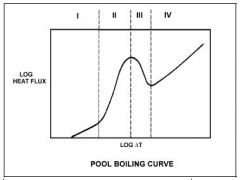
Refer to the drawing of a pool boiling curve (see figure below). Choose the region of the curve where transition boiling is the primary heat transfer process. A. Region I B. Region II C. Region III D. Region IV
|
C.
|
|
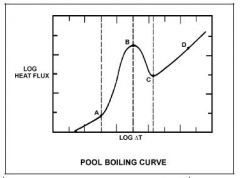
Refer to the drawing of a pool boiling curve (see figure below). Which one of the points shown represents the onset of transition boiling? A. A B. B C. C D. D
|
B.
|
|
|
Which one of the following describes the conditions in a fuel coolant channel that is experiencing transition boiling? A. Complete steam blanketing of the fuel rod surface B. Alternate wetting and drying of the fuel rod surface C. Saturated nucleate boiling D. Subcooled nucleate boiling
|
B.
|
|
|
Which one of the following describes the conditions in a fuel channel that is experiencing transition boiling? A. Complete steam blanketing of the fuel rod surface B. Alternate wetting and drying of the fuel rod surface C. Steam bubbles form and collapse on the fuel rod surface D. Steam bubbles form on the fuel rod surface and are swept away by subcooled bulk coolant
|
B.
|
|
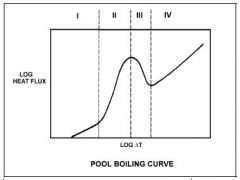
Refer to the drawing of a pool boiling curve (see figure below). Which one of the following describes the conditions in a fuel channel that is experiencing region III heat transfer? A. Complete steam blanketing of the fuel rod surface B. Alternate wetting and drying of the fuel rod surface C. Saturated nucleate boiling D. Subcooled nucleate boiling
|
B.
|
|

Refer to the drawing of a pool-boiling curve (see figure below). The point at which heat flux stops increasing and the critical heat flux has been reached (point B), marks the beginning of... A. nucleate boiling. B. stable film boiling. C. partial film boiling. D. single-phase convection.
|
C.
|
|
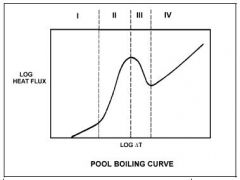
Refer to the drawing of a pool-boiling curve (see figure below). Which one of the following regions represents the most unstable heat transfer? A. I B. II C. III D. IV
|
C.
|
|
|
Film boiling is... A. the most efficient method of boiling heat transfer. B. heat transfer through an oxide film on the cladding. C. heat transfer being accomplished with no enthalpy change. D. heat transfer through a vapor blanket that covers the fuel cladding.
|
D.
|
|
|
Reactor power is increased sufficiently to cause steam blanketing of several fuel rods. This condition is being caused by... A. departure from nucleate boiling. B. subcooled nucleate boiling. C. saturated nucleate boiling. D. onset of nucleate boiling.
|
A.
|
|
|
If the fission rate in a nuclear reactor core steadily increases, the mode of heat transfer that occurs immediately after the critical heat flux is reached is called... A. transition boiling. B. subcooled nucleate boiling. C. saturated nucleate boiling. D. stable film boiling.
|
A.
|
|
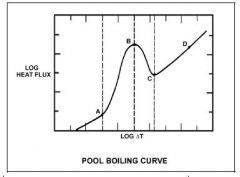
Refer to the drawing of a pool boiling curve (see figure below). Which one of the points shown marks the smallest ¥T at which stable film boiling can exist? A. A B. B C. C D. D
|
C.
|
|
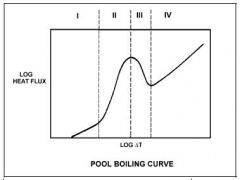
Refer to the drawing of a pool boiling curve (see figure below). Which one of the following describes the conditions in a fuel channel that is experiencing region IV heat transfer? A. Complete steam blanketing of the fuel rod surface B. Alternate wetting and drying of the fuel rod surface C. Saturated nucleate boiling D. Subcooled nucleate boiling
|
A.
|
|
|
During a loss of coolant accident, the reactor fuel may experience stable film boiling. Which one of the following types of heat transfer from the fuel cladding will increase significantly when stable film boiling begins? A. Forced convection B. Natural convection C. Conduction D. Radiation
|
D.
|
|
|
The departure from nucleate boiling (DNB) ratio is defined as the... A. actual heat flux divided by the critical heat flux at any point along a fuel rod. B. critical heat flux divided by the actual heat flux at any point along a fuel rod. C. core thermal power divided by the total reactor coolant mass flow rate. D. number of coolant channels that have reached DNB divided by the number of coolant channels that are subcooled.
|
B.
|
|
|
In the definition of the departure from nucleate boiling ratio, the term "actual heat flux" refers to the... A. heat transfer rate per unit area at any point along the fuel rod. B. average heat transfer rate per unit area across the core. C. integrated heat transfer rate along the entire fuel rod. D. total heat transfer rate along the entire fuel rod.
|
A.
|
|
|
A nuclear reactor is operating at 100 percent steady-state power at the end of core life with all control rods fully withdrawn. At what axial location in a typical fuel assembly will the minimum departure from nucleate boiling ratio occur? A. At the bottom of the fuel assembly. B. At the top of the fuel assembly. C. Between the bottom and the midplane of the fuel assembly. D. Between the midplane and the top of the fuel assembly.
|
D.
|
|
|
A nuclear reactor is operating at 100 percent steady-state power near the end of a fuel cycle with all control rods fully withdrawn. At what axial location in a typical fuel assembly will the maximum departure from nucleate boiling ratio occur? A. At the top of the fuel assembly B. At the bottom of the fuel assembly C. Between the bottom and midplane of the fuel assembly D. Between the midplane and the top of the fuel assembly
|
B.
|
|
|
If a nuclear reactor is operating with DNBR at its limit, which one of the following is indicated? A. None of the fuel rods are experiencing critical heat flux. B. A small fraction of the fuel rods may be experiencing critical heat flux. C. All radioactive fission products are being contained within the reactor fuel. D. All radioactive fission products are being contained within either the reactor fuel or the reactor vessel.
|
B.
|
|
|
Core heat transfer is maximized by the presence of... A. laminar flow with no nucleate boiling. B. turbulent flow with no nucleate boiling. C. laminar flow with nucleate boiling. D. turbulent flow with nucleate boiling.
|
D.
|
|
|
The heat transfer coefficient of the core will be directly increased if: (Assume bulk coolant subcooling.) A. the coolant temperature is decreased. B. the coolant flow rate is decreased. C. nucleate boiling occurs in the coolant. D. the coolant flow is laminar instead of turbulent.
|
C.
|
|
|
Increasing coolant flow rate through a nuclear reactor core improves heat transfer from the fuel because it __________ the laminar film thickness and __________ the temperature of the coolant adjacent to the fuel. A. increases; raises B. increases; lowers C. decreases; raises D. decreases; lowers
|
D.
|
|
|
Which one of the following will minimize core heat transfer? A. Laminar flow with no nucleate boiling B. Turbulent flow with no nucleate boiling C. Laminar flow with nucleate boiling D. Turbulent flow with nucleate boiling
|
A.
|
|
|
A nuclear power plant is operating at 100 percent power. The reactor coolant subcooling margin will be directly reduced by: A. increasing reactor coolant temperature. B. increasing pressurizer pressure. C. increasing reactor coolant flow. D. increasing pressurizer level.
|
A.
|
|
|
The difference between the actual temperature and the saturation temperature of a liquid is the... A. critical heat flux. B. subcooling margin. C. departure from nucleate boiling. D. saturation margin.
|
B.
|
|
|
Which one of the following must be present to assure adequate core cooling following a small loss-of-coolant accident? A. Emergency cooling injection flow rate on scale. B. Pressurizer level in the indicating range. C. Subcooling margin greater than zero. D. Pressurizer pressure greater than safety injection actuation setpoint.
|
C.
|
|
|
Which one of the following will increase the reactor coolant system (RCS) subcooling margin with the reactor operating at full power? A. Decreased RCS pressure. B. Decreased RCS hot leg temperature. C. Increased RCS cold leg temperature. D. Increased concentration of soluble gases in the RCS.
|
B.
|
|
|
A 60EF/hour reactor coolant system (RCS) cooldown and depressurization with natural circulation is in progress. After one hour, RCS subcooling will be minimum in the... A. reactor vessel head. B. RCS loop hot leg. C. RCS loop cold leg. D. reactor core.
|
A.
|
|
|
A reactor coolant system (RCS) cooldown and depressurization is in progress on natural circulation following a loss of offsite power. The following conditions exist: RCS Tcold: 520EF, decreasing RCS Thot: 538EF, decreasing Pressurizer pressure: 2,000 psia, decreasing If the cooldown rate is being maintained at 50EF/hour, which one of the following locations is most likely to experience steam formation? A. Reactor vessel head B. RCS loop hot leg C. Steam generator U-tubes D. Reactor core
|
A.
|
|
|
Which one of the following is most likely to result in steam bubble formation in a reactor vessel head while maintaining a 60EF subcooling margin in the hottest RCS hot leg? A. Performing a 25EF/Hr RCS cooldown on natural circulation. B. Performing a 50EF/Hr RCS cooldown on natural circulation. C. Performing a 25EF/Hr RCS heatup on forced circulation. D. Performing a 50EF/Hr RCS heatup on forced circulation.
|
B.
|
|
|
Which one of the following is most likely to result in steam bubble formation in a reactor vessel head while maintaining a 40EF subcooling margin in the hottest RCS hot leg? A. Performing a 25EF/Hr RCS cooldown on natural circulation. B. Performing a 25EF/Hr RCS cooldown on forced circulation. C. Performing a 50EF/Hr RCS cooldown on natural circulation. D. Performing a 50EF/Hr RCS cooldown on forced circulation.
|
C.
|
|
|
A nuclear power plant maintains the reactor coolant system (RCS) cold leg temperature (Tcold) at 557EF from 0 percent to 100 percent power. At 100 percent power, the reactor differential temperature (Thot - Tcold) is 60EF. If this plant also maintains RCS pressure constant at 2,235 psig, which one of the following is the approximate RCS subcooling margin at 50 percent power? A. 30EF B. 36EF C. 66EF D. 96EF
|
C.
|
|
|
Assume that a 30EF subcooling margin is maintained in the reactor coolant system (RCS) hot legs during each of the following shutdown reactor cooldown operations. Which one of the following will maintain the greatest subcooling margin in the reactor vessel head? A. Performing a 25EF/Hr RCS cooldown on natural circulation using one steam generator. B. Performing a 25EF/Hr RCS cooldown with all reactor coolant pumps running. C. Performing a 100EF/Hr RCS cooldown on natural circulation using all steam generators. D. Performing a 100EF/Hr RCS cooldown with one reactor coolant pump running.
|
B.
|
|

Refer to the drawing of a fuel rod and coolant flow channel at the beginning of a fuel cycle (see figure below). At 100 percent reactor power, the greatest temperature difference in a fuel channel radial temperature profile will occur across the: (Assume the temperature profile begins at the fuel centerline.) A. fuel pellet centerline to pellet surface. B. fuel pellet surface-to-clad gap. C. zircaloy cladding. D. flow channel boundary (laminar) layer.
|
A.
|
|
|
During a plant cooldown and depressurization with forced circulation, reactor coolant system (RCS) loop flow and reactor coolant pump (RCP) current indications become erratic. These abnormal indications are most likely caused by... A. RCP cavitation. B. RCP runout. C. RCS loop water hammer. D. RCS hot leg saturation.
|
A.
|
|
|
Single-phase coolant flow resistance (head loss) in a nuclear reactor core is directly proportional to the square of coolant __________ and inversely proportional to __________. A. velocity; fuel assembly length B. temperature; fuel assembly length C. velocity; coolant channel cross-sectional area D. temperature; coolant channel cross-sectional area
|
C.
|
|
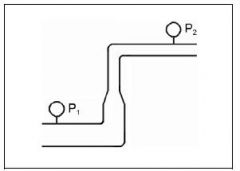
Refer to the drawing of a section of pipe that contains flowing water (see figure below). Given: Pressure at P1 is 24 psig. Pressure at P2 is 16 psig. Pressure change due to change in velocity is 2 psig. Pressure change due to change in elevation is 10 psig. The pressure decrease due to friction head loss between P1 and P2 is ____________; and the direction of flow is from ______________. A. 2 psig; left to right B. 2 psig; right to left C. 4 psig; left to right D. 4 psig; right to left
|
D.
|
|
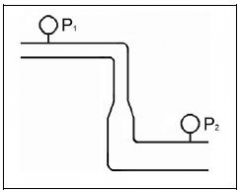
Refer to the drawing of a section of pipe that contains flowing subcooled water (see figure below). Given: Pressure at P1 is 26 psig. Pressure at P2 is 34 psig. Pressure change due to change in velocity is 2 psig. Pressure change due to change in elevation is 8 psig. The pressure decrease due to friction head loss between P1 and P2 is ____________; and the direction of flow is from ______________. A. 2 psig; left to right B. 2 psig; right to left C. 4 psig; left to right D. 4 psig; right to left
|
A.
|
|
|
A nuclear reactor is producing 3,400 MW of thermal output with a vessel ¥T of 60EF and a vessel mass flow rate of 1.4 x 108 lbm/hr. If core ¥T is 63.6EF, what is core bypass flow rate? (Assume bypass flow ¥T equals 0EF.) A. 7.92 x 106 lbm/hr B. 8.40 x 106 lbm/hr C. 1.26 x 108 lbm/hr D. 1.32 x 108 lbm/hr
|
A.
|
|
|
A nuclear reactor is producing 3,400 MW of thermal output with a vessel ¥T of 60EF and a vessel mass flow rate of 1.0 x 108 lbm/hr. If core ¥T is 63.6EF, what is core bypass flow rate? (Assume bypass flow ¥T equals 0EF.) A. 5.66 x 106 lbm/hr B. 8.40 x 106 lbm/hr C. 3.60 x 107 lbm/hr D. 9.43 x 107 lbm/hr
|
A.
|
|
|
A nuclear reactor is producing 3,400 MW of thermal output with a vessel differential temperature (¥T) of 60EF and a vessel mass flow rate of 1.1 x 108 lbm/hr. If core ¥T is 63.6EF, what is core bypass flow rate? (Assume bypass flow ¥T equals 0EF.) A. 5.66 x 106 lbm/hr B. 6.23 x 106 lbm/hr C. 5.66 x 107 lbm/hr D. 6.23 x 107 lbm/hr
|
B.
|
|
|
Adequate core bypass flow is needed to... A. cool the excore nuclear instrument detectors. B. provide reactor coolant pump minimum flow requirements. C. prevent stratification of reactor coolant inside the reactor vessel. D. equalize the temperatures between the reactor vessel and the upper vessel head.
|
D.
|
|
|
Which one of the following describes a function of core bypass flow? A. Prevents excessive reactor vessel wall differential temperature B. Prevents boron precipitation in the core baffle area C. Provides a means of measuring core flow D. Provides cooling to various reactor vessel internal components
|
D.
|
|
|
Which one of the following is a function of core bypass flow? A. Provides even flow distribution through the fuel. B. Provides mixing of water in the reactor vessel head. C. Ensures that core exit thermocouple readings represent average fuel temperatures. D. Ensures that natural circulation will be initiated when forced circulation is lost.
|
B.
|
|
|
Maximizing the elevation difference between the core thermal center and the steam generator thermal centers and minimizing flow restrictions in the reactor coolant system (RCS) piping are plant designs that... A. minimize the RCS volume. B. maximize the RCS flow rate during forced circulation. C. ensure a maximum RCS loop transit time. D. ensure RCS natural circulation flow can be established.
|
D.
|
|
|
Which one of the following must exist for natural circulation flow to occur? A. The heat source must be larger than the heat sink. B. The heat source must be located higher than the heat sink. C. The heat sink must be larger than the heat source. D. The heat sink must be located higher than the heat source.
|
D.
|
|
|
The driving head for natural circulation flow through the core is developed by differences in __________ between the hot leg and the cold leg. A. water density B. water volume C. pipe diameter D. piping length
|
A.
|
|
|
If the steam generator thermal centers were at the same elevation as the reactor core thermal center, natural circulation flow in the reactor coolant system would... A. not occur. B. not be affected. C. be greater than if they were at different elevations. D. flow in the reverse direction.
|
A.
|
|
|
A nuclear reactor is shut down with natural circulation core cooling. Decay heat generation is equivalent to 1.0 percent of rated thermal power. Stable natural circulation mass flow rate is 1,000 gpm. When decay heat generation decreases to 0.5 percent of rated thermal power, stable natural circulation flow rate will be approximately... A. 125 gpm. B. 250 gpm. C. 707 gpm. D. 794 gpm.
|
D.
|
|
|
A nuclear reactor is shut down with natural circulation core cooling. Decay heat generation is equivalent to 1.0 percent of rated thermal power. Core ¥T has stabilized at 16EF. When decay heat generation decreases to 0.5 percent of rated thermal power, core ¥T will be approximately... A. 2EF. B. 4EF. C. 8EF. D. 10EF.
|
D.
|
|
|
Establishing natural circulation requires that a heat sink be ____________ in elevation than a heat source and that a ____________ difference exist between the heat sink and heat source. A. lower; pressure B. lower; temperature C. higher; pressure D. higher; temperature
|
D.
|
|
|
Which one of the following conditions must occur to sustain natural circulation in a fluid system? A. Subcooling of the fluid B. A phase change in the fluid C. A density change in the fluid D. Radiative heat transfer to the fluid
|
C.
|
|
|
A nuclear reactor is shut down with natural circulation core cooling. Decay heat generation is equivalent to 1.0 percent of rated thermal power. Core ¥T has stabilized at 16EF. When decay heat generation decreases to 0.333 percent of rated thermal power, core ¥T will be approximately... A. 2EF. B. 4EF. C. 8EF. D. 10EF.
|
C.
|
|
|
A nuclear reactor is shut down with natural circulation core cooling. Decay heat generation is equivalent to 1.0 percent of rated thermal power. Core ¥T has stabilized at 13EF. When decay heat generation decreases to 0.5 percent of rated thermal power, core ¥T will be approximately... A. 4EF. B. 6EF. C. 8EF. D. 10EF.
|
C.
|
|
|
A nuclear reactor is shut down with natural circulation core cooling. Decay heat generation is equivalent to 1.0 percent of rated thermal power. Stable natural circulation flow rate is 800 gpm. When decay heat generation decreases to 0.5 percent of rated thermal power, stable natural circulation flow rate will be approximately... A. 400 gpm. B. 565 gpm. C. 635 gpm. D. 696 gpm.
|
C.
|
|
|
A nuclear power plant is operating at 100 percent power when a loss of offsite power occurs, resulting in a reactor trip and a loss of forced reactor coolant circulation. After 30 minutes, reactor coolant system (RCS) hot leg temperature is greater than cold leg temperature and steam generator (SG) levels are stable. Which one of the following combinations of parameter trends, occurring 30 minutes after the trip, indicates that natural circulation is occurring? (CET = core exit thermocouple) RCS Hot Leg RCS Cold Leg SG RCS CET Temperature Temperature Pressures Subcooling A. Decreasing Stable Stable Increasing B. Increasing Decreasing Increasing Decreasing C. Decreasing Decreasing Decreasing Decreasing D. Increasing Increasing Decreasing Increasing
|
A.
|
|
|
A nuclear reactor is operating at 100 percent power when a loss of offsite power occurs, resulting in a reactor trip and a loss of forced reactor coolant circulation. Reactor coolant system (RCS) hot leg temperature is greater than cold leg temperature and all other parameters (e.g. steam generator (SG) levels) are stable. Which one of the following combinations of parameter trends, occurring 2 hours after the trip, indicates that natural circulation is not occurring? (CET = core exit thermocouples) RCS Hot Leg RCS Cold Leg SG RCS CET Temperature Temperature Pressures Subcooling A. Stable Stable Decreasing Decreasing B. Stable Decreasing Decreasing Stable C. Decreasing Decreasing Decreasing Increasing D. Decreasing Stable Stable Increasing
|
A.
|
|
|
A nuclear reactor is shut down at normal operating temperature and pressure with all reactor coolant pumps stopped. Stable natural circulation cooling is in progress with 50EF of RCS subcooling. Which one of the following, if increased, will not affect natural circulation flow rate? A. Reactor coolant pressure B. Time after reactor trip C. Feed water flow rate D. Steam generator pressure
|
A.
|
|
|
Fully-developed natural circulation flow rate will be greatest when... A. all reactor coolant pumps stop sequentially within 1 hour after a reactor trip. B. all reactor coolant pumps stop at the same time the reactor trips. C. all reactor coolant pumps run for 1 hour after a reactor trip, and then stop. D. only one reactor coolant pump runs for 1 hour after a reactor trip, and then stops.
|
B.
|
|
|
Natural circulation flow can be enhanced by... A. increasing the elevation of the heat source to equal that of the heat sink. B. increasing the temperature difference between the heat sink and the heat source. C. decreasing the temperature difference between the heat sink and the heat source. D. decreasing the elevation difference between the heat source and the heat sink.
|
B.
|
|
|
Which one of the following will enhance natural circulation flow in the reactor coolant system? A. Pressurizer level decreases. B. Steam generator level increases. C. Pressurizer pressure decreases. D. Steam generator pressure increases.
|
B.
|
|
|
A nuclear reactor had been operating at a constant power level for the last two weeks when a loss of all ac power occurred, thereby causing a reactor trip and a loss of forced reactor coolant flow. Natural circulation reactor coolant flow developed and stabilized 30 minutes after the trip. Which one of the following combinations of initial reactor power and post-trip steam generator pressure will result in the highest stable natural circulation flow rate 30 minutes after the trip? Initial Post-trip Steam Reactor Power Generator Pressure A. 100 percent 1,100 psia B. 25 percent 1,100 psia C. 100 percent 1,000 psia D. 25 percent 1,000 psia
|
C.
|
|
|
A nuclear reactor had been operating at a constant power level for the last two weeks when a loss of all ac power occurred, thereby causing a reactor trip and a loss of forced reactor coolant flow. Natural circulation reactor coolant flow developed and stabilized 30 minutes after the trip. Which one of the following combinations of initial reactor power and post-trip steam generator pressure will result in the lowest stable natural circulation flow rate 30 minutes after the trip? (Assume constant steam generator water levels.) Initial Post-trip Steam Reactor Power Generator Pressure A. 100 percent 1,100 psia B. 25 percent 1,100 psia C. 100 percent 1,000 psia D. 25 percent 1,000 psia
|
B.
|
|
|
A nuclear reactor had been operating at steady state 100 percent power when a loss of offsite power occurred, thereby causing a reactor trip and a complete loss of forced reactor coolant flow. Natural circulation reactor coolant flow developed and stabilized approximately 30 minutes after the trip. Which one of the following combinations of reactor power history and post-trip steam generator pressure will result in the highest stable natural circulation flow rate? Days At Post-trip Steam Full Power Generator Pressure A. 12 1,100 psia B. 100 1,100 psia C. 12 1,000 psia D. 100 1,000 psia
|
D.
|
|
|
A few minutes ago, a nuclear power plant experienced a loss of offsite power that caused a reactor trip and a loss of all reactor coolant pumps. Natural circulation flow is currently developing in the reactor coolant system (RCS). Which one of the following operator actions will enhance RCS natural circulation flow rate? A. Establish and maintain saturation conditions in the RCS. B. Establish and maintain a steam bubble in the reactor vessel. C. Establish and maintain steam generator pressure above RCS pressure. D. Establish and maintain steam generator water level high in the normal operating range.
|
D.
|
|
|
During the reflux boiling method of core cooling, the steam that is generated in the core is condensed in the ____________ side of a steam generator and flows back into the core via the ____________. (Assume the steam generators contain U-tubes.) A. hot leg; hot leg B. cold leg; hot leg C. hot leg; cold leg D. cold leg; cold leg
|
A.
|
|
|
Which one of the following describes the method of core heat removal during reflux core cooling following a loss of coolant accident? A. Convection with forced coolant flow. B. Convection with natural circulation coolant flow. C. Conduction with stagnant coolant flow. D. Radiation with total core voiding.
|
B.
|
|
|
A nuclear power plant is experiencing natural circulation core cooling following a loss of coolant accident. Which one of the following, when it first occurs, marks the beginning of reflux core cooling? (Assume the steam generators contain U-tubes.) A. Reactor core steam production results in two-phase coolant entering the hot leg and being delivered to the steam generators. B. Hot leg steam quality is so high that the steam generators cannot fully condense it and two-phase coolant is returned to the reactor vessel via the cold leg. C. Hot leg condensation is unable to pass completely through the steam generators to enter the cold legs. D. The steam generators are no longer able to condense any of the steam contained in the hot leg.
|
C.
|
|
|
A reactor coolant system cooldown is in progress on natural circulation via the steam generator (SG) atmospheric steam relief valves (operated in manual control). If high point voiding interrupts natural circulation, which one of the following will occur? (Assume feed flow rate, relief valve position, and decay heat level are constant.) A. SG level increases and SG pressure increases. B. SG level increases and SG pressure decreases. C. SG level decreases and SG pressure increases. D. SG level decreases and SG pressure decreases.
|
B.
|
|
|
A reactor coolant system natural circulation cooldown is in progress via the steam generator (SG) atmospheric steam relief valves (operated in manual control). Assume feed flow rate, relief valve position, and decay heat level are constant. If high point voiding interrupts natural circulation, SG levels will gradually __________; and core exit thermocouple indications will gradually ____________. A. decrease; increase B. decrease; decrease C. increase; increase D. increase; decrease
|
C.
|
|
|
A reactor coolant system natural circulation cooldown is in progress using the steam generator (SG) atmospheric steam relief valves (operated in manual control). If voids interrupt natural circulation, which one of the following will occur? (Assume feed flow rate, relief valve position, and decay heat level are constant.) A. SG pressure decreases and core exit thermocouple (CETC) temperature increases. B. SG pressure decreases and CETC temperature remains constant. C. SG pressure increases and CETC temperature increases. D. SG pressure increases and CETC temperature remains constant.
|
A.
|
|
|
A reactor coolant system natural circulation cooldown is in progress using the steam generator (SG) atmospheric steam relief valves, operated in manual control. Assume feed flow rate, relief valve position, and decay heat level remain constant. If SG tube high point voiding interrupts natural circulation, SG steam flow rate will _________ and core exit thermocouple temperature will _________. A. decrease; increase B. decrease; remain constant C. increase; increase D. increase; remain constant
|
A.
|

